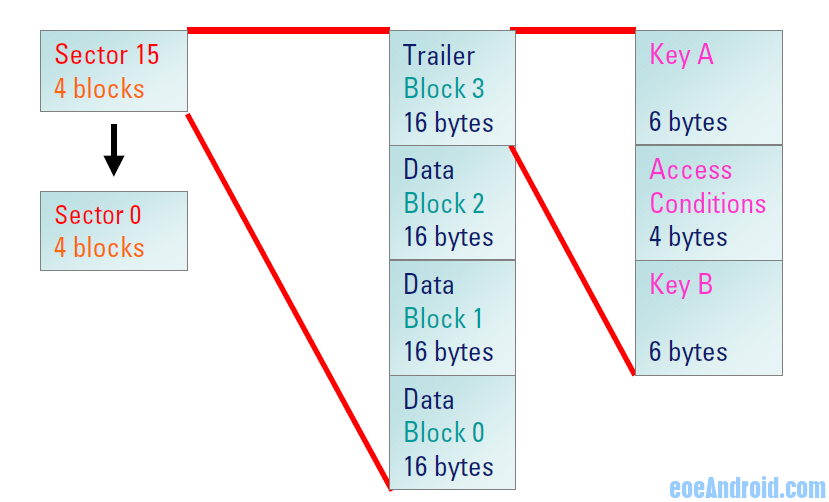本篇文章为大家展示了Android NFC开发中Mifare Tag读写的示例分析,内容简明扼要并且容易理解,绝对能使你眼前一亮,通过这篇文章的详细介绍希望你能有所收获。
针对常用的Mifare Tag具体说明。
Mifare Tag 可以有1K ,2K, 4K,其内存分区大同小异,下图给出了1K字节容量的Tag的内存分布:

数据分为16个区(Sector) ,每个区有4个块(Block) ,每个块可以存放16字节的数据,其大小为16 X 4 X 16 =1024 bytes。
每个区***一个块称为Trailer ,主要用来存放读写该区Block数据的Key ,可以有A,B两个Key,每个Key 长度为6个字节,缺省的Key值一般为全FF或是0. 由 MifareClassic.KEY_DEFAULT 定义。
因此读写Mifare Tag 首先需要有正确的Key值(起到保护的作用),如果鉴权成功:
auth = mfc.authenticateSectorWithKeyA(j, MifareClassic.KEY_DEFAULT);
然后才可以读写该区数据。
本例定义几个Mifare相关的类 MifareClassCard ,MifareSector, MifareBlock 和MifareKey 以方便读写Mifare Tag.
Android 系统来检测到NFC Tag, 将其封装成Tag类,存放到Intent的NfcAdapter.EXTRA_TAG Extra 数据包中,可以使用MifareClassic.get(Tag) 获取对象的 MifareClassic类。
Tag tagFromIntent = intent.getParcelableExtra(NfcAdapter.EXTRA_TAG); // 4) Get an instance of the Mifare classic card from this TAG // intent MifareClassic mfc = MifareClassic.get(tagFromIntent);
下面为读取Mifare card 的主要代码:
// 1) Parse the intent and get the action that triggered this intent String action = intent.getAction(); // 2) Check if it was triggered by a tag discovered interruption. if (NfcAdapter.ACTION_TECH_DISCOVERED.equals(action)) { // 3) Get an instance of the TAG from the NfcAdapter Tag tagFromIntent = intent.getParcelableExtra(NfcAdapter.EXTRA_TAG); // 4) Get an instance of the Mifare classic card from this TAG // intent MifareClassic mfc = MifareClassic.get(tagFromIntent); MifareClassCard mifareClassCard=null; try { // 5.1) Connect to card mfc.connect(); boolean auth = false; // 5.2) and get the number of sectors this card has..and loop // thru these sectors int secCount = mfc.getSectorCount(); mifareClassCard= new MifareClassCard(secCount); int bCount = 0; int bIndex = 0; for (int j = 0; j < secCount; j++) { MifareSector mifareSector = new MifareSector(); mifareSector.sectorIndex = j; // 6.1) authenticate the sector auth = mfc.authenticateSectorWithKeyA(j, MifareClassic.KEY_DEFAULT); mifareSector.authorized = auth; if (auth) { // 6.2) In each sector - get the block count bCount = mfc.getBlockCountInSector(j); bCount =Math.min(bCount, MifareSector.BLOCKCOUNT); bIndex = mfc.sectorToBlock(j); for (int i = 0; i < bCount; i++) { // 6.3) Read the block byte []data = mfc.readBlock(bIndex); MifareBlock mifareBlock = new MifareBlock(data); mifareBlock.blockIndex = bIndex; // 7) Convert the data into a string from Hex // format. bIndex++; mifareSector.blocks<i> = mifareBlock; } mifareClassCard.setSector(mifareSector.sectorIndex, mifareSector); } else { // Authentication failed - Handle it } } ArrayList<String> blockData=new ArrayList<String>(); int blockIndex=0; for(int i=0;i<secCount;i++){ MifareSector mifareSector=mifareClassCard.getSector(i); for(int j=0;j<MifareSector.BLOCKCOUNT;j++){ MifareBlock mifareBlock=mifareSector.blocks[j]; byte []data=mifareBlock.getData(); blockData.add("Block "+ blockIndex++ +" : "+ Converter.getHexString(data, data.length)); } } String []contents=new String[blockData.size()]; blockData.toArray(contents); setListAdapter(new ArrayAdapter<String>(this, android.R.layout.simple_list_item_1, contents)); getListView().setTextFilterEnabled(true); } catch (IOException e) { Log.e(TAG, e.getLocalizedMessage()); showAlert(3); }finally{ if(mifareClassCard!=null){ mifareClassCard.debugPrint(); } } }运行结果:

上述内容就是Android NFC开发中Mifare Tag读写的示例分析,你们学到知识或技能了吗?如果还想学到更多技能或者丰富自己的知识储备,欢迎关注亿速云行业资讯频道。
免责声明:本站发布的内容(图片、视频和文字)以原创、转载和分享为主,文章观点不代表本网站立场,如果涉及侵权请联系站长邮箱:is@yisu.com进行举报,并提供相关证据,一经查实,将立刻删除涉嫌侵权内容。